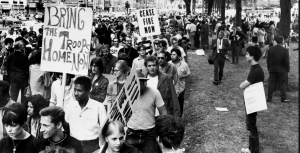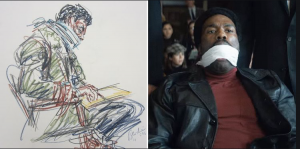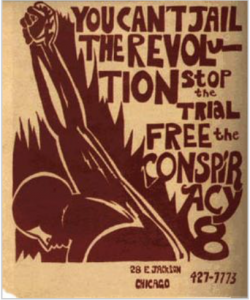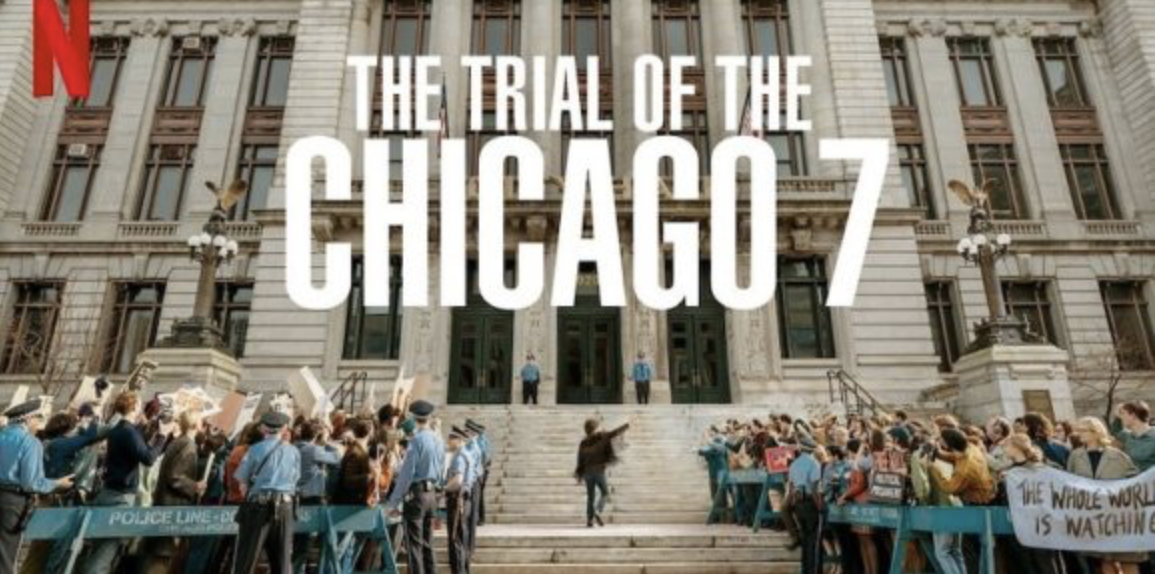There have been a number of reviews written about Aaron Sorkin’s film The Trial of the Chicago Seven (available on Netflix). The film is a fictional account of the trial of leaders of the anti Vietnam War movement who came to Chicago in 1968 to protest both the Democratic Party’s nomination of “New Deal liberal” Hubert Humphrey for President of the United States and the Vietnam War. Most of reviews focus on how the film departs from what really happened and how it depicts the defendants, their attorneys and the judge. This review will focus on why I think this is an important film for young activists who were not around in 1968.

In 1968 the Democratic Party held its Presidential Convention in Chicago. The Vietnam War was at its height. A politically diverse assortment of anti war activists came to protest not only the war, but the Democratic Party’s nomination of Humphrey who supported the war. At a “Festival of Life” where Yippie organizer Abby Hoffman promised city authorities there would be “rock and roll, drugs and public fornication, chants of “Dump the Hump” and “One Two Three Four, we don’t want your fucking war” seemed to astound the Party officials and infuriated Chicago Mayor Richard Daley. Daley ordered his police to shoot to kill or maim violent protesters. And the police responded by taking the offensive using brutal tear gas barrages and clubbing. The demonstrators valiantly fought back. But the police attack, which was being televised as the Democratic Party delegates celebrated with straw hats, balloons and a band playing “”Happy Days are Here Again” shocked the world. As the demonstrators chanted, “The Whole World is Watching,” venerable CBS news anchor Walter Cronkite was so moved that he said on the air that the Democratic Party Convention was being held “in a police state.”
The Republican Party candidate, Richard Nixon, was ultimately elected President, and as soon as he took office he instructed his Attorney General John Mitchell to make sure the demonstrators were punished. His top prosecutors were sent to Chicago and indicted eight people for conspiracy to cross state lines to commit violence. The film focuses on the trial and shows footage of the police attacks as a backdrop to what was said in the courtroom.
There are a number of things to criticize about the film, which I will get to momentarily. But I want to offer two reasons why young activists should watch a film about a trial that happened more than fifty years ago. First, the film gives a good basis for understanding the diversity of political tendencies represented in the Vietnam anti war movement and how the different factions dealt with each other. Secondly, it is important to see the total disconnect between the vibrant political movements represented at the 1968 protests and the liberal Democratic Party politics on display at the Convention.

On the first point, it is necessary to give a little context that the film does not provide. In 1968, the U.S. was in the throes of a national youth uprising. First came the black Civil Rights Movement. This movement began in the South by challenging “separate but equal” segregation laws, the refusal of service or segregation in businesses that served the public, and asserting black voting rights. These challenges ultimately became a broader black liberation movement and expanded to include the entire nation. The black liberation movement was followed by a strong women’s movement, an LGBTQ movement, an indigenous rights movement, an immigrant rights movement. The country was already experiencing surges of protests on these and other fronts when the anti war movement started in 1965.
In response to these movements, there was a great deal of violent repression. The violence of the Vietnam War and the violence against the liberation movements in the U.S. fueled the movements. Here are just a few examples, not seen in the film, of what those of us who were radicalized in the 1960s experienced. Demonstrations in the South were routinely met with mob violence in which police either stood by or participated. In the summer of 1961 freedom rides were organized to defy laws against integrated interstate bus transportation. The freedom riders were met with unfettered mob violence. In 1963, the Klan planted a bomb in a black church in Birmingham, Alabama, killing four children. A major civil rights leader, Medgar Evers, was assassinated by the Klan in Jackson Mississippi in 1963. President John F. Kennedy was assassinated in Dallas Texas in the same year. In the summer of 1964, civil rights organizations conducted voter registration drives throughout the South and were met with violent resistance. Three civil rights workers were arrested in Neshoba County, Mississippi that summer and their bodies were later found buried in a remote area. In 1965 demonstrators attempting to march in Selma, Mississippi were badly beaten by deputized citizens and the police. Later a civil rights leader who had come from Detroit, Viola Liuzzo, was shot to death in her car by the Klan. Revolutionary black leader Malcolm X was assassinated in New York in 1965. Both Martin Luther King and the pro civil rights Senator Robert F. Kennedy were assassinated in 1968.
The growing strength of liberation movements and the violent reaction to them offer a glimpse of the political/social context of the 1968 demonstrations in Chicago and the trial that followed. The various social movements that participated in the demonstrations in Chicago offered an array of political approaches that were mostly represented at the defendants’ table at the trial. Abby Hoffman and Jerry Rubin were among the founders of the Youth International Party (YIP) who were known as Yippies. They believed in militant confrontation with the establishment that had a strong counter cultural element. David Dellinger, was a founder of the National Mobilization Committee to End the War in Vietnam (Mob). He was older than the rest of the defendants. And he was a committed pacifist who had been in prison for resisting service in World War II. Tom Hayden and Rennie Davis were among the founders of Students for a Democratic Society (SDS) and were not only committed to the anti war movement but believed that the path to a new society would come through what today we call “democratic socialism.” John Froines and Lee Weiner were anti war college professors. Finally Bobby Seale was national chairman of the Black Panther Party, a distinct segment of the black liberation movement.
All of these different politics were on display inside and outside the courtroom. And they are depicted in the film. William Kunstler and Leonard Weinglass were attorneys for the defense, but Bobby Seale wanted his own attorney who was ill when the trial started. Seale was being informally advised by Chicago Black Panther Chairman, Fred Hampton. The judge, Julius Hoffman, ordered Kunstler to defend Seale while denying a motion to postpone the trial so Seale could have the attorney of his choice. Seale refused to be represented by Kunstler and, in solidarity with Seale and the Panthers, Kunstler refused to represent Seale. When Seale attempted to intervene by insisting on cross examining the witnesses against him, he was removed from the courtroom, beaten, then brought into the court in chains and was bound and gagged in his chair. In the midst of the trial and adding to the incredible horror of a black man being publically mistreated, Seale’s friend and advisor Fred Hampton was murdered by the police while sleeping in his bed. The film uses actual footage of news coverage of the assassination to good effect. All of this had such a global political reaction that a mistrial was declared in Seale’s case and his case was separated from the rest of the other defendants.

Throughout the film there are dialogues among the defendants that bring out some of the different politics and subsequent approaches to the issues of the day. The white defendants are clearly respectful of Bobby Seale and the Panthers, they do their political work separately. Seale will not accept any legal advice from Kunstler who respects his wishes. Yet there is solidarity displayed, especially when Seale is gagged and chained to his chair. Both the attorneys and white defendants share in the outrage when they learn that Fred Hampton has been murdered by the police.
The film correctly suggests that Tom Hayden and Rennie Davis had a very different view of what the trial was all about than did Abby Hoffman and Jerry Rubin. At one point there is an argument between Hayden and Hoffman that almost comes to blows. Hayden is dismissive of Hoffman’s use of the trial to mock American jurisprudence and society. And he tells him to stop his regular appearances at coffee houses where he uses the trial as material for stand up comedy routines. Hayden expresses the view that they should focus on beating the charges against them so they are in a position in the future to run for public office. Hoffman mocks this view and says that this is a “political trial” and they should treat it as such. He sees the trial as an opportunity to expose the American system that has brought on the Vietnam War. Attorney Kunstler interjects at this point: “There is no such thing as a political trial. There are only civil and criminal trials. This is a criminal trial and the point is to get you off.” Hayden nods in agreement but eventually as the trial drags on, Kunstler changes his mind and also sees the trial as political.

There are many exchanges like this in the film that today’s activists will relate to and learn from. But there is a second reason why watching this film is important for today. While the film does not make this explicit, the 1960s and 1970s represented a sharp cultural break from the previous generation. At the end of World War II, the U.S. economy boomed and special government programs allowed white workers to live a “middle class” life style and move to the suburbs. The political conservatism this engendered was buoyed by the use of white male supremacy and anti-communism. The booming economy made the reduction of white women’s role to housewife possible and a variety of forms of institutionalized racism kept people not white out of the mix. The social mores of the white establishment were hypocritically “moral.” The explosion of the youth rebellion in this context challenged the 1950s mentality and did so through the civil rights movements of black, latinx, indigenous people, women, LGBTQ, Chicano/Mexicano and the anti war movements. The 1960s movements busted through and challenged all of the assumptions of the 1950s.
But the various movements came at this from different directions and experiences. For example, there is a scene in the film where Bobby Seale says to Tom Hayden: “I bet you are rebelling against your parents. That’s fine but I also bet your parents were never swinging from a rope.” The Yippies saw the need to break with the 1950s culturally through their sometimes outrageous antics including using profane language, promoting sexual promiscuity, and mocking all symbols of authority. David Dellinger, a dedicated pacifist, promoted non-violent resistance to war and racial discrimination (he and Kunstler were part of the 1950s generation but had broken from it). Hayden and Davis agreed with non-violence and thought they should work to reform American institutions. The Panthers focused on black liberation while countering the ravages of racial oppression with social services like their hot breakfast and political education program for children. And they broke with Martin Luther King’s non-violence through their advocacy of armed self-defense. They joined with other parts of the youth movement by embracing anti- capitalism and anti-imperialism as the basis for their opposition to the Vietnam War.
The film demonstrated that the 1950s generation hadn’t a clue about what was going on. Bob Dylan wrote a song about this.
“You know something’s happening.
But you don’t know what it is.
Do you, Mr. Jones.”
So the Establishment reacted viciously – not only with police beating demonstrators, but with the use of violence against the movements highlighted by the murder of Fred Hampton and other Panthers.
At one point in the film Abby Hoffman is telling a group of supporters about an incident when the police kettled him and a number of demonstrators in front of a plate glass window to a bar. He described the bar as
“…a watering hole for Democratic Party elites and their hookers. Everyone in there was living in the 1950s and those of us on the other side of the window were living in the 1960s. Then the police push us through the window and we tumble bleeding into the bar. The 1950s got to meet the 1960s”.
This disconnect was also fully on display when the Democratic Party conventioneers were able to carry on with their balloons and straw hats as if nothing was happening as the police beat the crap out of demonstrators outside.

An even better depiction of this disconnect is in another film I would highly recommend. Medium Cool (available on You Tube) came out in 1969. The great film-maker, Haskell Wexler, came to Chicago and filmed both the demonstrations and police riot as well as the convention and used this footage as a backdrop for the story of a white film journalist pursuing the story of a black cab driver who returned money he found in his cab. He goes to the cab driver’s Southside home to do some interviews and is confronted by his family who relate to the Panthers. Their hostility completely mystifies him and he realizes he does not understand the black liberation movement at all. Then he gets involved with a white woman on the far North side of Chicago who had settled in Chicago’s Uptown neighborhood when the West Virginia mines closed. Her husband, a former coal miner, is dead and she struggles to make ends meet. These stories are also juxtaposed against the Democratic Party Convention. The conventioneers, the Appalachian whites, the black people on the South Side and the demonstrators all seem disconnected from one another. Watching the Trial of the Chicago Seven and Medium Cool together may give today’s activists much to think about.
Recommending the Chicago Seven film is not to say it does not have some serious flaws. Reviewers who criticized the depiction of the various players in the trial are quite correct. Aaron Sorkin, who was the creator and writer of the romantic TV series West Wing put his own liberal believe-in-the-system stamp on the 1968-69 events portrayed in the film. His Hollywood ending of the film where he has Tom Hayden reading the names of the war dead in court as the judge bangs his gavel and the defendants and spectators stand with their fists in the air to the tune of emotional music never happened. In fact, the Vietnam War itself goes on for another six years. And the assassinations and the violent reaction to the movements continue long after the trial. The specific violence against people of color also continued and that legacy of the terroristic backlash against black liberation movements expresses itself today in the police killings of back people.
One of the best reviews of the film was by Nancy Kershan. She states that the film “left out the rest of us.” In other words, you get little sense of the various movements that brought demonstrators to Chicago. The depth of the black liberation movements including the Panthers was not captured by the film. And, as Kershan points out, women are completely left out of the film despite the fact that they were as much victims of the police riot and a part of the protest movements as men. She relates the fact that the film shows a bunch of women burning their bras, making the women’s movement look frivolous. But in fact she, as one of the founders of the Youth International Party, along with two other women, burn judges robes in front of the courthouse opposing not only women’s oppression but the American judicial system itself.
Flaws aside, it is well worth the time of today’s activists to see this film as well as Medium Cool. They give us a great deal to think about and in my case to reflect on.

